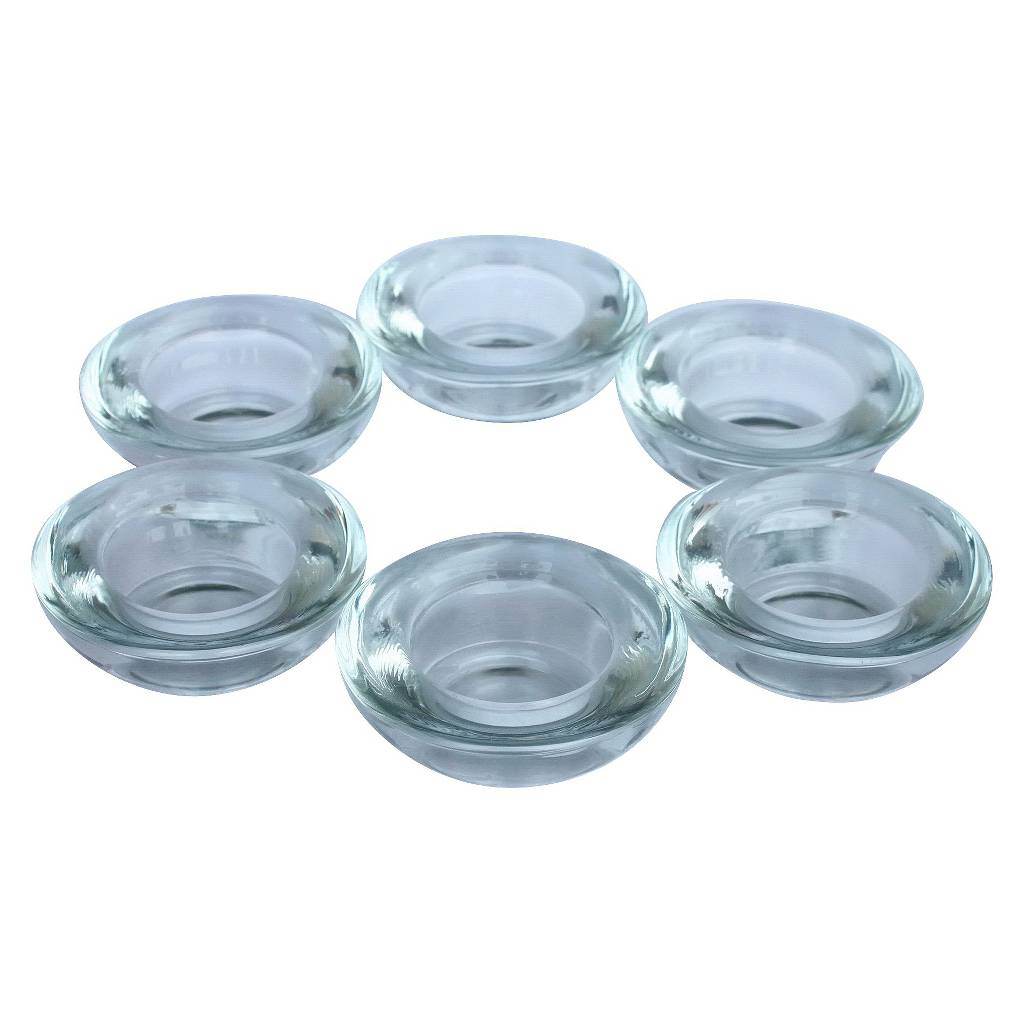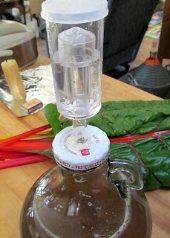
 9
9




Do I need an airlock to make sauerkraut, kimchi, and other fermented foods?
There is a lot of debate out there as to whether or not you need to airlock your veggie-ferments. People are very passionate and sometimes a bit carried away. There is supporting evidence for both sides, but as you may have noticed I prefer the open vat method. In this post, I would like to give you a simple overview of the debate and tell you a bit about why I decided that the airlock is optional.
Open vat fermentations are basically a wide mouth container, some veg, some salt, some water, and possibly a starter culture. The veg is weighed down with an inner lid and a weight like a rock or bottle of water and covered with a towel to keep out flies and dust. The inner lid and weight insure that all the veg stay below the level of the brine, and thus out of contact with the air during the fermentation.
The top of the brine, however, is exposed to the air. Sure there is a slight layer of CO2 gas (fermentation farts) that settle on the undisturbed brine, which protects against some O2 (oxygen) contact, but how well it works is limited.
Airlock ferments have basically the same contents as the open vat, only an extra stage is taken to prevent the surface of the brine from touching oxygen. This will be something that allows the ferment farts (CO2) to escape without letting any gas back in. The Pickl-It system is the best example of this, but some people use those snap jars with the rubber rings like this one:

The airlock school of thought has some great science that talks about how many more good bacteria an airlock system can produce and how that the part of the brine that has exposure to O2 reduces the amount of these specific bacteria and grows air-friendly invisible beasties.
I've read the science, I'm not disputing any of it. It's good science!
However, it does rely on a few assumptions.
1. exposure to all air bacteria (aerobic) is harmful to us
2. if some anaerobic (living without air) bacteria (invisible beasties) for us is good, then way more of it is better
2.5 this also assumes that our body has an unlimited ability to use these bacteria.
3. That it is only the anaerobic bacteria that is good for us.
4. It is only the quantity of the bacteria that is good for us, not the ratio.
I am slightly obsessed with the history of food and food preservation pre-refrigeration. Lacto-fermentation - the fancy name for what happens when you make sauerkraut and what we've been talking about this entire post - ... Lacto-fermentation has been used by people for a few thousand (probably a few ten-thousand) years, and during this time, it was almost always in an open vat kind of system. The 'airlocks' available until the 19th Century, were slightly porous, which allowed the food to breath. For example, a bladder (pre-20th Century clear-wrap) is very slightly porous and over time, 'breaths'.
So I look at history and I see that for most of human history people have been using open vat fermentation without any obvious ill effects. Especially none of the ill effects that some of the more enthusiastic pro-airlock followers declare will happen.
Looking at what we are learning about ecosystems (because what is a gut full of invisible beasties if not an ecosystem? - rhetorical question), human health, and history, it makes me wonder if looking only at the quantities is missing out on the really important aspect of fermenting (and how it relates to our health). Maybe there could be something to the ratios of invisible beasties - and possibly, just possibly, maybe using an airlock is detrimental to our health. This needs more study.
For those of you on the receiving end of those well-meaning lectures as to why you must only ever always use an airlock when fermenting. Be strong. These people have a lot of science and aren't afraid to use it. They are also very intelligent and vocal. It's hard to stand against that, especially when all you have is an unarticulated feeling in your gut that maybe something they say isn't right, but you can't find any fault in their logic or science.







 1
1




Check out Redhawk's soil series: https://permies.com/wiki/redhawk-soil
 3
3




... it´s about time to get a signature ...
 1
1




Tobias Ber wrote:great post ... thank you ...
i wonder how many of the articles/posts on the internet that say you ll need an airlock are from people who are selling these airlocks...







 1
1





 8
8




![Filename: Glass-jars-are-nice-but-too-expensive-for-the-volumes-we-need.jpg
Description: [Thumbnail for Glass-jars-are-nice-but-too-expensive-for-the-volumes-we-need.jpg]](/t/55941/a/39294/Glass-jars-are-nice-but-too-expensive-for-the-volumes-we-need.jpg)
Works at a residential alternative high school in the Himalayas SECMOL.org . "Back home" is Cape Cod, E Coast USA.

 5
5




Ask me about food.
How Permies.com Works (lots of useful links)

 1
1




 3
3




... it´s about time to get a signature ...
 3
3










www.ultimatepicklejar.com
 2
2















www.ultimatepicklejar.com
 5
5















 It is how I feel. The only thing I would do would be add the word "commercial" in front of airlock.
It is how I feel. The only thing I would do would be add the word "commercial" in front of airlock.
www.ultimatepicklejar.com
 4
4











 1
1




 1
1




alex Keenan wrote:Nukadoko (Fermented Rice Bran Bed) for Pickling
This is a very old and well understood form of fermenting.
It is clearly not air tight.
 I think this type fermenting is over my head and out of my comfort zone to personally attempt
I think this type fermenting is over my head and out of my comfort zone to personally attempt
www.ultimatepicklejar.com
 2
2




Mike Harmon wrote:
alex Keenan wrote:Nukadoko (Fermented Rice Bran Bed) for Pickling
This is a very old and well understood form of fermenting.
It is clearly not air tight.
Yes this does not require a commercial airlock for sureI think this type fermenting is over my head and out of my comfort zone to personally attempt
 1
1




Don't let perfect be the enemy of good.

 5
5





 (Hm, did I learn that from Paul, or is that a reason why we're a good match?
(Hm, did I learn that from Paul, or is that a reason why we're a good match?  )
)
QuickBooks set up and Bookkeeping for Small Businesses and Farms - jocelyncampbell.com
 1
1




Don't let perfect be the enemy of good.







 1
1




Ask me about food.
How Permies.com Works (lots of useful links)







 1
1




QuickBooks set up and Bookkeeping for Small Businesses and Farms - jocelyncampbell.com
 1
1




You mentioned slime and mold. A lot of folks scrape that off the top and keep the ferment, though that's hard for me to do. In the video I shared, if I recall, I think that happen to a batch and then the blind taste testers didn't like its flavor.

Don't let perfect be the enemy of good.






 5
5




K Putnam wrote:
I do think the glass weights made a big difference in keeping the tips of anything from surfacing above the brine. I think even having that 1/4" or 1/2" creep above the surface now and then is enough to spoil a batch.


QuickBooks set up and Bookkeeping for Small Businesses and Farms - jocelyncampbell.com
 1
1




 5
5




 1
1




Apartment-dwelling hopeful future permie
 1
1




 1
1




r ranson wrote:Luckily, no one on this forum would attempt to shame anyone else to use or not use an airlock, as it would break the Be Nice rule. It's nice to have alternatives, so that each individual can make their choice.
It was mentioned that airlocks reduce the chance of failure, my experience is this is true with starter cultures ( aka, mothers or store bought cultures) and sterilized ferments, but I've never had this with wild ferments. The air contains the same microbes as are in the skin of the veggies we rely on to start our fermentation. Some people like to keep these out, I don't see the need for short term ferments of less than a month or two.
Someone said that we all use an airlock. Really? We must be using different definitions of airlock. Here's my current chili sauce batch. Jar open, smaller jar inside to prevent garlic from floating, a light towel to keep the dust out. I'm not seeing the airlock, as I won't be closing the lid until the ferment is in finished burping and into storage.





Hans Albert Quistorff, LMT projects on permies Hans Massage Qberry Farm magnet therapy gmail hquistorff

|
I met your mom on a Carribean cruise and she said you would help me and this tiny ad:
Learn Permaculture through a little hard work
https://wheaton-labs.com/bootcamp
|



